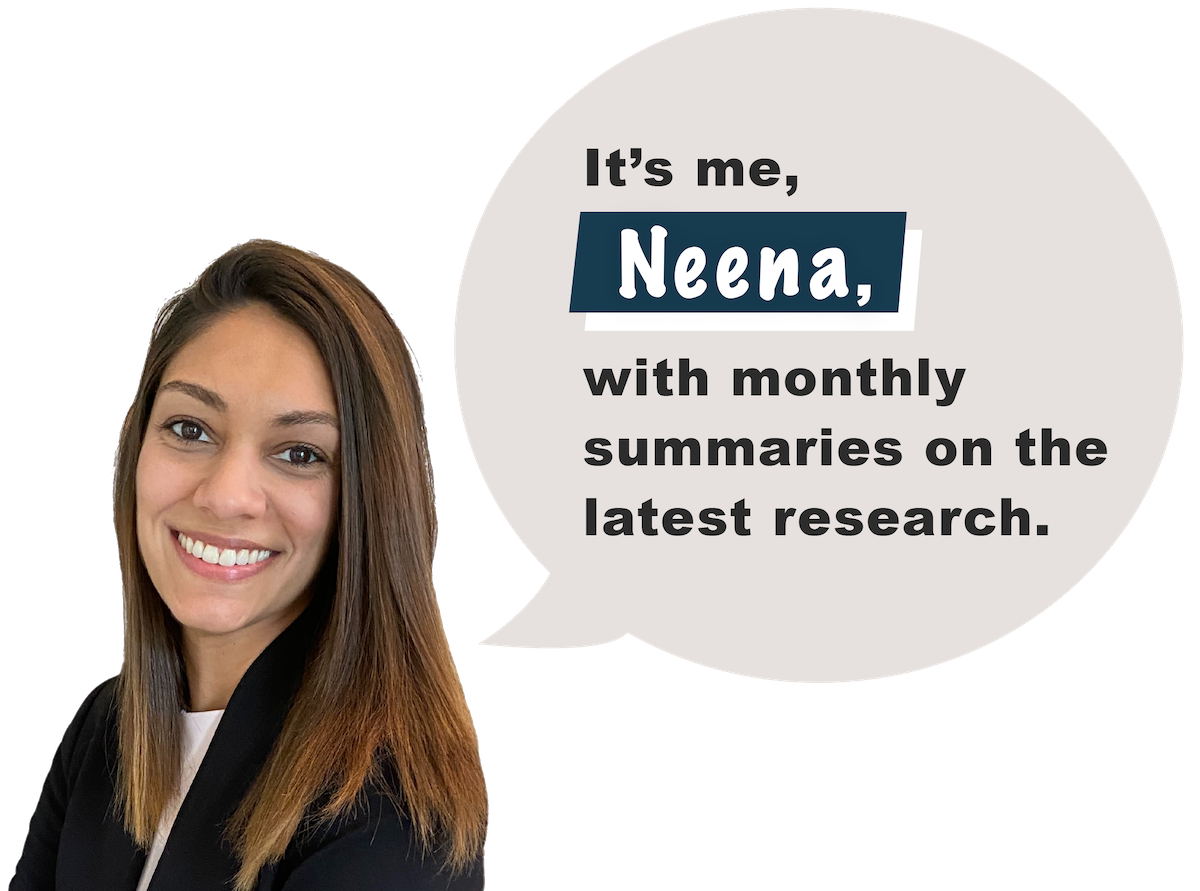 Welcome to the Reading Research Recap!
Welcome to the Reading Research Recap!
I am Dr. Neena Saha, Research Advisor at MetaMetrics and founder and CEO of Elemeno, now a part of MetaMetrics. My focus is to bridge the research-practice gap so that educators can access real-time tools to support reading success. To expand the understanding of research to inform teaching and learning strategies, I put together this monthly compendium of the relevant and must-read research that impacts the reading and learning landscape. I offer research highlights in digestible summary slices. Hopefully, the data and findings you see here are useful to you as researchers, educators, and district and edtech leaders.
Time to Transfer: Long-Term Effects of a Sustained and Spiraled Content Literacy Intervention in the Elementary Grades
Hi all! 😱Aaaaa!! It is getting really hard to choose papers for the deep dive! There seem to be so many good ones out there! I’ve been in touch with 3 different research groups — and I will do my best to cover their papers soon — but this month I just had to bump this paper on Sustained and Spiraled Content Literacy up in the queue!
Why? Well, the TL;DR version is that it was a large (30 schools), rigorous (RCT) study with amazing results for students on the following outcomes:
- Vocabulary knowledge
- Grade 3 science reading (ES = .14)
- Domain-general reading comprehension (ES = .11)
…and as if that weren’t enough, students in the intervention also saw positive transfer to mathematics achievement (ES = .12). And, wait, there’s more! There were even treatment effects 14 months later (!) for reading comprehension (ES = .12) and mathematics achievement (ES = .16).
Background
- There is wide agreement that background knowledge is important (see my February Recap on Background Knowledge).
- Yet, there are very few studies on building background knowledge in the early elementary grades.
Rationale
Furthermore, the lead author, James S. Kim, on the paper believes that existing knowledge-building programs are unlikely to result in transfer:
“About half a dozen other knowledge-building curricula are widely available, but Kim felt none of them connected simpler to more complex topics across grade levels in the way most likely to result in measurable transfer.”
— Excerpt from Forbes article, by Natalie Wexler,
The Forbes article is on the results of the study after 2 years, before they found evidence of far transfer or sustained effects. The new study being reported below answers the question raised in the Forbes article and says, for far transfer effects, it takes about 3 years.
Sample
- 30 elementary schools (N = 2,870 students) were randomized to a treatment or control condition.
Design
- In the treatment condition (i.e., full spiral curriculum), students participated in content literacy lessons from Grades 1 to 3 during the school year and wide reading of thematically related informational texts in the summer following Grades 1 and 2.
- In the control condition (i.e., partial spiral curriculum), students participated in lessons in only Grade 3.
Treatment Group Intervention: The MORE Curriculum
This study used the model of reading engagement (MORE) curriculum, which focuses on:
- Fostering schema awareness.
- Gradually introducing complex topics.
- Developing academic vocabulary networks.
- Promoting far-transfer.
There is a lot more 🙂 about MORE here.
Shameless Plug: The MORE curriculum had more complex texts as measured by Lexile measures!
“A notable difference between the two conditions was that the read-aloud books used in the MORE intervention consisted of informational texts with significantly higher readability levels as measured in Lexiles…”
Results
In short: It works! The children who received the MORE intervention outperformed control (business-as-usual) students on several outcome measures:
- Vocabulary knowledge
- Grade 3 science reading
- Domain-general reading comprehension*
- Mathematics achievement*
*the effects were still present 14 months later (!)
Classroom Implications
Sustained and spiraled content literacy programs should be implemented in grades 1-3.
“This experimental study illustrates how sustaining and spiraling science schemas (background knowledge) and vocabulary from Grades 1 to 3 can improve students’ ability to comprehend passages in science, English language arts, and mathematics. Furthermore, findings suggest that systematically building background and vocabulary knowledge can sustain positive gains in elementary-grade students’ reading comprehension ability through the end of Grade 4, 14 months after the conclusion of the intervention activities.”
What Are The Researchers’ Plans to Scale It?
Given the pretty incredible results, I asked the authors what their plans were to try and scale it up. The short answer: yes, they are working on it:
“…our next project is about taking MORE to a larger scale through an Education Innovation and Research grant funded by DOE (read more here), so we are actively exploring strategies to replicate our work at large scale.”
“…we have some clear plans on how we’d like to scale, and we plan to scale it ourselves, as opposed to the more common approach of consulting for larger educational companies or creating a program and then selling it to a larger company. I think there are lots of examples where that model has failed students.”
Additional Resources on MORE:
Here are some additional resources provided by the paper authors:
- READS Lab website, listing all of the recent studies. Lots more details about the MORE program on the MORE website.
- Two-page, non-technical summaries of the latest study, the 2023 study and the 2021 study.
- A phi delta kappan piece on teaching for transfer that draws on this same research base.
- Related READS lab studies on measuring transfer and facilitating transfer through structured supplements.
- A write up of the 2023 study in Forbes.
Ok, that’s all I have for the deep dive for April! I hope you enjoyed it!!
Teacher Knowledge, Resources, Practices, and Professional Development
- Graph Out Loud: Pre-Service Teachers’ Data Decisions and Interpretations of CBM Progress Graphs
- Artificial Intelligence . . . In the Early Childhood Special Education Classroom!!?
- Technical adequacy of measuring teachers’ knowledge of dyslexia
- A multiple-case study of reading comprehension: How do teachers understand and teach reading comprehension? (Dissertation not yet peer-reviewed)
- The Predictive Relationship Between Teachers’ Knowledge of Dyslexia and Their Confidence in Supporting Students With Dyslexia (Dissertation, not yet peer-reviewed)
- Connecticut Teachers’ Knowledge of The Science of Reading (Dissertation, not yet peer-reviewed)
- A Response to Legislating Phonics: Settled Science or Political Polemics? by Reinking, Hruby, & Risko (2023): In Defence of the Scientific Method Related to Reading Instruction (opinion)
At-risk Readers, Dyslexia
- Do we really need a new definition of dyslexia? A commentary (open access!)
- The experience of parenting a child with dyslexia – A UK perspective with single parents (open access!)
- Identifying kindergarteners at-risk of writing difficulties based on foundational literacy skills
- Computerized Executive Functions Training: The efficacy on reading performance of children with dyslexia
- Application of cluster analysis to identify different reader groups through their engagement with a digital reading supplement
- Cross-Age Peer Tutoring to Improve Literacy Outcomes for Students With Disabilities (open access)
- Unraveling individual differences in learning potential: a dynamic framework for the case of reading development
- Action video games normalise the phonemic awareness in pre-readers at risk for developmental dyslexia
- DLD Policy Brief: A Synopsis of Federal-Level Dyslexia Law (policy brief)
- The Dyslexia Debate Revisited (I read the first book and it became a bit controversial – interested to read this next one!)
Phonological Awareness, Decoding, Phonics
- Closing the Gap: A Conceptual Replication of an Early Reading Intervention
- Is a Picture Worth a Thousand Words? Not Necessarily, for the Phonological Awareness of Young Children
- Following the Rules in an Unruly Writing System: The Cognitive Science of Learning to Read English
- Reexamining the Dolch Basic Sight Word List: Contemporary Considerations for Culturally Sustaining Approaches to Assess Sight Word Development
- The CPB Sight Words: A New Research Based High-Frequency Wordlist for Early Reading Instruction
- Enhancing Opportunities for Decoding and Knowledge Building through Beginning Texts
- How orthographic knowledge is related to efficient word reading? Testing competing hypotheses
- Profiles of Children’s phonological awareness and prediction of reading and spelling outcomes (open science pre-registered project)
Oral Reading Fluency
- Utilizing Text-Generative AI for Creating Oral Reading Fluency Probes
- A Multilevel Meta-Analysis of Synchronous Paired Oral Reading Techniques in Elementary Classrooms
- Comparison of an iPad and Paper-Based Modality for a Flashcard Sight-Phrase Intervention
Comprehension, Oral Language
- Inference skills for reading: A meta-analysis of instructional practices
- A Randomized Controlled Trial of Tutor- and Computer-Delivered Inferential Comprehension
- Interventions for Middle School Students with Reading Difficulties
- A Randomized Controlled Trial of Tutor- and Computer-Delivered Inferential Comprehension Interventions for Middle School Students with Reading Difficulties
- Reciprocal relationships among reading and vocabulary over time: a longitudinal study from grade 1 to 5 (open access!)
- An implementation case study for the Response to Intervention (RTI) approach for oral language and reading instruction in the early years of primary school
- Reevaluating and Restructuring Comprehension Strategy Instruction
- Supporting Students’ Knowledge Activation before, during, and after Reading
Writing
- Graphomotor and Handwriting Disabilities Rating Scale (GHDRS): towards complex and objective assessment
- Enhancing Reading and Writing Skills through Systematically Integrated Instruction
Other
- A meta-analysis of technology-delivered literacy instruction for elementary students
- What Environments Support Reading Growth Among Current Compared With Former Reading Intervention Recipients? A Multilevel Analysis of Students and Their Schools
- Executive functioning predicts development of reading skill and perceptual span seven years later
- Digital reading comprehension instruction in English for children with English as an additional language: A systematic review (open access!)
- Morphological assessment features and their relations to reading: A meta-analytic structural equation modeling study

Want to start receiving monthly notifications for this series?
Please register or sign in to your Lexile® & Quantile® Hub account and join our Reading Research mailing list.

